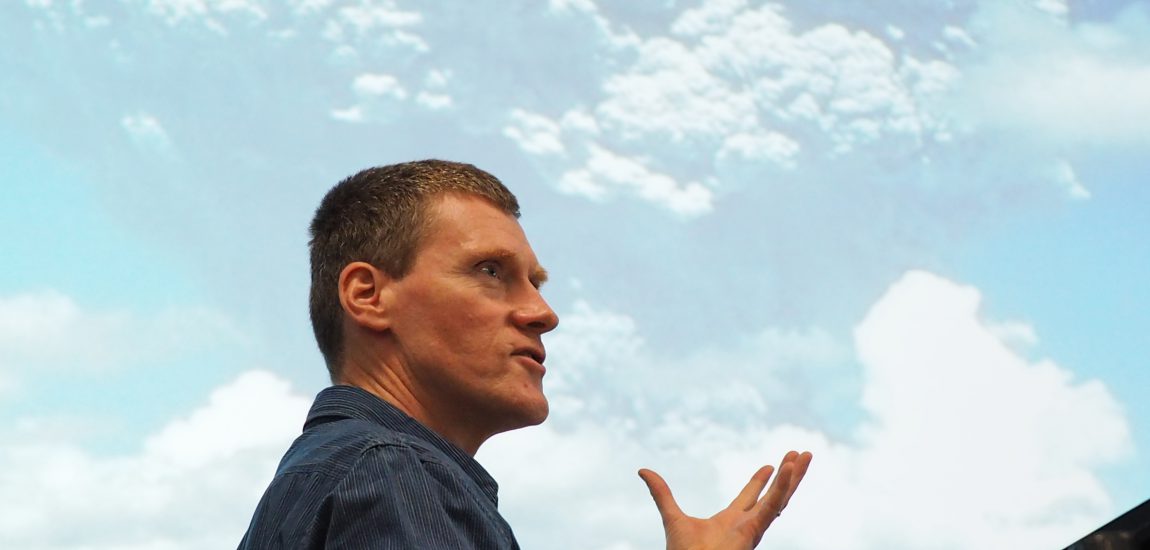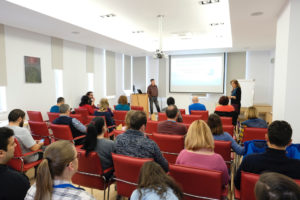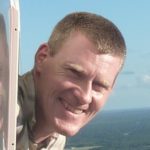
2018 Distinguished Lecture Tour: Jim McQuaid’s Eastern adventure

When I was first told that I had the honour of being the 2018 EAG Distinguished Lecturer, I did wonder how I would present atmospheric science to geochemists. It turned out to be much easier than I thought. I originally did a chemistry degree and then moved into atmospheric chemistry, so I am a chemist “by birth”. My current research involves a great deal of geochemistry, part of it studying the ability of minerals to produce clouds high up in the atmosphere and also I work with geochemists investigating the interactions between minerals, airborne pollution (black carbon) and microbes on the surface of the Greenland Icesheet. So the links are all there and it only needed a small introduction to make the link across to the primary science of the EAG.
Just two weeks before the first lecture of my European tour, I was taking part in a fell race in the Black Mountains in South Wales when I fell and broke my ankle. Fortunately, after a discussion, we were able to push on with plans and my first port of call was Krakow in Poland. I have only visited Warsaw previously so it was interesting to learn about the industrial past of the area and the challenges that face those studying the environment as we move into times where we consider our impact on our surroundings rather than just how we can benefit from it, or exploit it as some might say. I had a ‘deck’ of four lectures that I had put together for institutes to choose from, and the group in Krakow had selected ‘Geoengineering the Climate’ and ‘High altitude mineral dust and ice clouds’. I love using analogies to illustrate the science I am presenting, the more bizarre the better is my mantra. One of my favourites is using stout to explain scattering of solar radiation by aerosols and cloud droplets. I won’t explain in detail here (you’ll just have to watch the video!) but I will say that a slide showing nothing but a glass of beer always gets people’s attention!
From Poland, I moved on to Hungary and the city of Budapest to give another pair of talks, this time on volcanoes coupled with high altitude mineral dust and ice clouds. Often there are members of the audience much more knowledgeable in a subject than I, and I was already in the habit of opening a talk about mineral dust to a room of geochemists to warn them of this. This was certainly the case in Krakow and again in Budapest, but it always means that I get to learn lots of new and interesting angles on my talk that I haven’t considered previously.
Science is all about collaboration, talking to lots of different people and creating new links. During the evening meal, as the group introduced their own particular area of research, I had one of those lightbulb moments: “Do you guys know Marek at Jagiellonian University in Krakow?” The topic had turned to nanospheres of iron, a subject I had been discussing just a couple of days before in Poland. So I happily did an email introduction to the groups in Poland and Hungary, hoping that this would prove to be fruitful in the future. The research group I joined for supper in Budapest was probably the most geographically diverse I have spent time with. Over the years I have done a lot of fieldwork with many international colleagues, but in this group of eight, there were seven nationalities! This is a great aspect of doing science. So few people have the opportunity to spend time with people from so many different backgrounds and cultures, and I like to think that there are no borders in science, or very few at least.
Veszprém was my next destination. I admit this was a city that I had not heard of before, so I did a little bit of research and it turns out that Veszprém is a city built on seven hills, just like Rome. I am originally from Sheffield, a city with the same claim, so this particular fact stuck in my memory. The venue for my lecture was Veszprém castle, the home of the Regional Centre of the Hungarian Academy of Sciences. The audience was more general than the previous two visits, a public lecture with different but no less interesting questions about geoengineering. The venue was also to be my overnight accommodation. I’ve never stayed in a castle before and I think it might be some time until I repeat that feat!
The last visit on this part of my tour took me to Bucharest, which I discovered was so far east that I had entered a new time zone. Having forgotten to change my watch on arriving, the phone call from Victor Nicolae the following morning, who lives close to the hotel and had kindly offered me a ride to the university, was a little unexpected! After a very interesting tour of the remote sensing facilities, including some impressive lidars at the institute, Victor took me back to the airport. He is proud of his home and in heavy rain took me past the Palace of the Parliament, which is a simply immense building, where immense really means very big indeed! Being the second largest building in the world after the Pentagon, it took some time to drive round it, I’ll tell you that!
My final tour stop was in Zagreb, where I gave a pair of lectures that were possibly the most closely linked, on geoengineering the climate and the role of atmospheric mineral dust in modifying surface albedo and cloud radiative properties. This pairing reinforced how much science is interconnected and that disciplines need to step out of their own little silos and talk to each other. Often this starts with a cup of coffee and just evolves naturally. I feel that one of the most important roles of learned societies such as the EAG is to facilitate these discussions and we must never lose sight of this. I would like to thank the EAG and its outreach committee and all those who hosted me and helped with my travel plans. It all worked out very smoothly, despite my injury!View the lectures from the 2018 Distinguished lecture tour at www.eag.eu.com/outreach/dlp/lecture-tour-2018/.
About the author
Dr Jim McQuaid is based in the School of Earth and Environment at the University of Leeds. His research is primarily focused upon observations of the composition of both gas phase and aerosol species in the atmosphere. Over the last 20 years he has participated in a large number of research campaigns both ground-based and airborne across the globe. He has been involved in studying a range of diverse topics including long range transport of pollutants across the Atlantic and over Europe, emissions from biomass burning activities in South and West Africa as well as from the Amazon and more recently the distribution of ice nucleating particles in remote regions.

